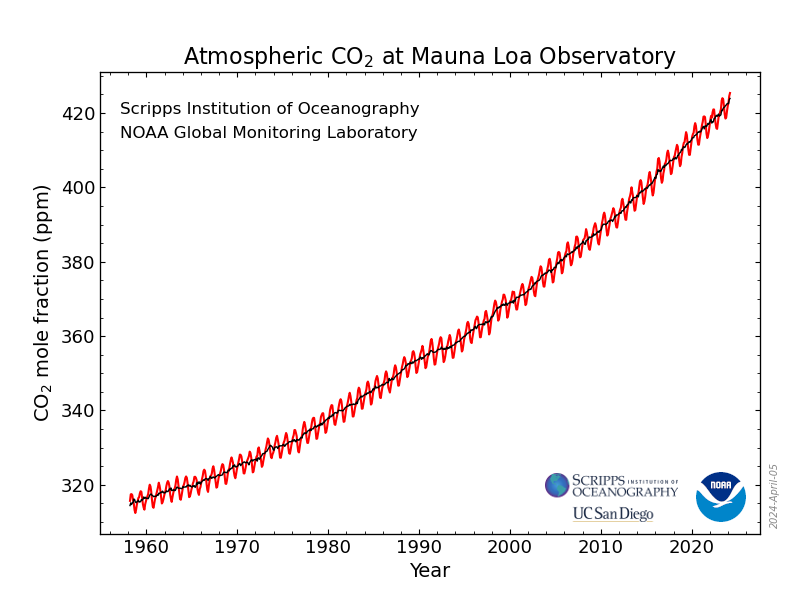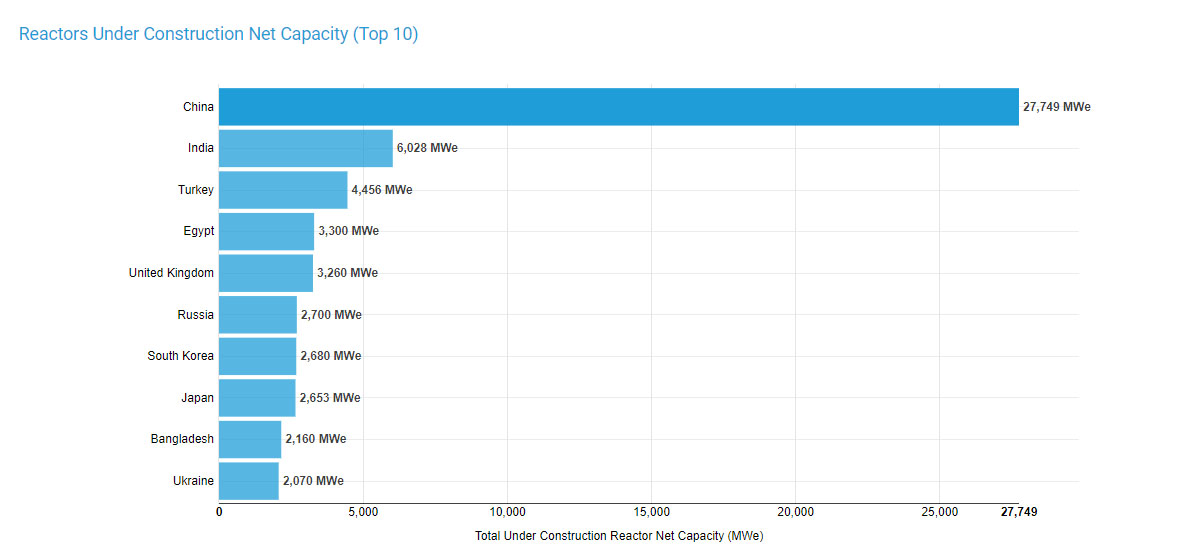Science
Related: About this forumOverview of 2023's CO2 Weekly and Monthly Concentration Data at the Mauna Loa Observatory.
Last edited Sun Jan 14, 2024, 10:44 AM - Edit history (1)
As I've indicated repeatedly in my DU writings, somewhat obsessively I keep a spreadsheet of the weekly data at the Mauna Loa Carbon Dioxide Observatory, which I use to do calculations to record the dying of our atmosphere, a triumph of fear, dogma and ignorance that did not have to be, but nonetheless is, a fact.
Facts matter.
When writing these depressing repeating posts about new records being set, reminiscent, over the years, to the ticking of a clock at a deathwatch, I often repeat some of the language from a previous post on this awful series, as I have been doing here with some modifications. It saves time.
As I note in this series of posts, the concentrations of the dangerous fossil fuel waste carbon dioxide which are killing the planet fluctuate sinusoidally over the year, with the rough sine wave superimposed on a quadratic axis:

Monthly Average Mauna Loa CO2
In this particular post, I will look over the weekly and monthly data reported at the Observatory, which like every year of the 21st century has set new records for the highest concentration of the dangerous fossil fuel waste carbon dioxide.
Here is the data for week 52, which includes the first days of 2024:
Week beginning on December 31, 2023: 422.40 ppm
Weekly value from 1 year ago: 419.34 ppm
Weekly value from 10 years ago: 397.73 ppm
Last updated: January 06, 2024
Weekly average CO2 at Mauna Loa
This is, if one hasn't joined Greenpeace and can thus add and subtract, 3.06 ppm higher than week 52 of 2022.
Overall the average increase week to week comparators among the 52 weeks of 2023 with those of 2022 was 2.56 ppm.
The average weekly concentration of the dangerous fossil fuel waste carbon dioxide in the planetary atmosphere was, in 2023, 421.13 ppm, compared to 418.27 ppm in 2022, 416.42 ppm in 2021, and 414.03 ppm in 2000.
The highest concentration, an all time record, was set in the week beginning May 28, 2023, 424.64 ppm.
Four of the 50 highest weekly values out of 2501 weekly data reported at Mauna Loa going back to 1975 occurred in 2023. Of these 50 top highest, 12 have occurred in the last 5 years; 33 occurred in the last 10 years, and 40 in the 21st century. Of the 10 that occurred in the 20th century, six occurred in 1998 when the rain forests in S.E. Asia caught fire after slash and burn fires set to make palm oil plantations for "renewable biodiesel" for Germany went out of control.
There have been 65 years of monthly data recorded at Mauna Loa. January 2023 through March 2023 were relatively mild, with average concentrations were "only" 1.53 ppm higher than the same months of 2022. April 2023's increase over April 2022 was 3.05 ppm, the third highest April increase reported, as was May 2023's increase of 3.01 ppm over May 2022, June (2.69 ppm), the 6th highest ever, July 2023, (3.24 ppm) the second highest ever recorded, October (3.04 ppm) the 3rd highest ever recorded, November (2.95 ppm) the 4th highest ever recorded, and December (2.91 ppm) the 2nd highest ever recorded at Mauna Loa.
Maybe someone here thinks we're doing something about climate change.
We aren't.
Enjoy the rest of the weekend and, oh yeah, happy New Year.
RandomNumbers
(19,035 posts)But doing the same things in the same ways, as the current 8+ billion? (except reproduction of course, for 4B obviously there would be less of that. Or there would be more killing - a lot more - which is why I raise this purely theoretically.)
My point is that population DOES matter. Some at DU (posters I know to be otherwise liberal) apparently disagree.
Realizing it doesn't change the FACT that we have to do something about what these 8+billion people are doing. But one of the areas we should be looking at, is certainly reproduction and population, and how to soften the so-called "demographic issue" as the population gets older (which issue would be a non-issue in a fair society that cared about its people, but then we are back in theory land of course).
NNadir
(37,061 posts)Source: Poverty
Killing all 800 million of them would have very little effect on climate change.
Killing 300 million Americans might have some effect, I think, or perhaps killing a billion Chinese. We might be able to address climate change rapidly by killing both all the Chinese, and all the Americans together.
The problem, I think, has less to do with the raw number of people than it does with the number of people who want to live like Americans, or even like Germans or even, as may be the case for India, like the Chinese.
Who deserves to die so the survivors can declare themselves "Green?"
It is well understood that in cultures where women are well educated, where people feel secure in their homes, where there is reliable and effective health care, negative population growth is observed, for example, Japan and Finland.
I note that countries experiencing declining birth rates consider the event to be problematic, since a reduced younger population is required to support a growing older population.
If one is to accept my belief that this is true that the way to address population growth is to address poverty, arguably the real issue to address is that of poverty as opposed to absolute numbers in the population. I would disagree with those who think that the way to address poverty is to convert wilderness into industrial parks for wind turbines and solar cells and, in addition, covert the Congo River basin into cobalt mines to support batteries.
Clean, carbon free energy has been well known since the 1950's, and began to scale in the 1960's and 1970's. People comfortable with fossil fuels and not with clean. carbon free energy were trained by dishonest marketing to hate clean carbon free energy, engaging in absurd fetishes that still appear here and elsewhere. One can see, for instance, over in the Ennui and Excuses forum, fossil fuel salespeople who are working to rebrand fossil fuels as "hydrogen" (accompanied by exergy destruction) whipping the crowds up into paroxysms of stupidity carrying on about trivial tritium releases at Fukushima.
Maybe we can skip killing off the Chinese and Indians who want to live like Americans, thinking, somehow, that they have a right to do so.
They seem to be doing something meaningful about climate change as opposed to wallowing in fear and ignorance:

Reactor Database.
I could be wrong about this, but I kind of have the opinion that the use of fossil fuels to support the population may have more to do with climate change than the population itself.
I do agree that the carrying capacity of the planet has been exceeded, probably since the 1960's or 1970's, but it's not clear that increasing death rates is necessarily an ethical approach to addressing the problem.
RandomNumbers
(19,035 posts)(actually TWO questions, to avoid the exact insulting inference that you jumped to anyway)
1. What would it look like if population had by now only grown to 4 billion instead of 8 billion?
2. What would it look like today, if population had managed to grow to 16 billion instead of 8 billion?
The premise for each scenario is: other than reproductive activities and resulting population growth, the types and frequency of human activities were approximately the same per person. (realizing this might be physically impossible in the second scenario, but make it as close as possible.)
I would add here that each scenario should assume similar distribution of population around the world. So in the first scenario, 50% less population means 50% less everywhere - so 50% in the high-consumption regions and 50% in the low-consumption regions.
---
To respond more directly to your reply: of COURSE I am not talking about deliberately killing off a bunch of people. That is why it is stated as a theoretical. (I really thought I was clear about that in my post).
The POINT is that population matters. That people who care about climate change should care about ensuring access to voluntary means of reproductive control, as well as other approaches that tend to stabilize populations and reduce the birthrate, while caring for the entire population adequately.
It bothers me when otherwise caring liberals buy into the capitalist dogma of the need for perpetual growth to sustain the economy and support the older population. (with "perpetual growth" also requiring a growing population). That is pure bullshit and liberals should know better. I was hoping your excellent OP, if extrapolated mathematically on the population vector (as a thought exercise anyway), might help make it clear.
NNadir
(37,061 posts)It is irrelevant at this point, which colors my response.
Covid did, albeit trivial, not because of the death toll but because of shut down of industry, have a slight effect on climate, and perhaps, if it killed a billion people it might have effected climate change more than it did.
We can argue until the end of our lives about "would have," and "could have," but that merely distracts from is.
We are not the only species, of course, that expands beyond its carrying capacity and then collapses as a result when resources are depleted. Bacteria do it all the time. However we are a rare, and certainly the most broadly applicable, tool making species.
Malthus argued in a less than generalized way about resources and population, focusing on food. His predicted catastrophe was prevented by the invention of the Haber-Bosch process for making ammonia.
I believe it is technically feasible to address climate change; hardly easy; hardly cheap, but my readings suggest it's feasible. "Feasible" is not a word coterminous with "likely." The "feasible" will not happen in an environment in which embracing ignorance becomes a popular practice.
People like Guy de Chauliac argued during the "Black Death" bubonic plague that there might be another approach to addressing the pandemic beyond prayer. Of course, he did not have the tools to carry his ideas to fruition, but he left a mark, despite the collapse of the European population. Mysticism won out with obvious loss to humanity.
We do have the tools, but from where I sit, it looks as if mysticism is winning again, the mystical and absurd idea that the release of any radioactive materials anywhere at anytime is a vast tragedy whereas the continuous release of fossil fuel waste, which actively kills people, is acceptable.
In any case, I apologize for the harsh tone of my response, but I'm tired of this notion that "theory" trumps reality.
It doesn't.
In science, if the theory doesn't correspond to reality, the theory is dropped rather than denying the reality.
Have a nice day.
NNadir
(37,061 posts)When I went for my daily check of the data at the Observatory, I saw that the figures included in the OP have been updated for the week beginning December 31, 2023. The new figures for that week are:
Week beginning on December 31, 2023: 422.52 ppm
Weekly value from 1 year ago: 419.34 ppm
Weekly value from 10 years ago: 397.73 ppm
Last updated: January 08, 2024
Weekly average CO2 at Mauna Loa (Accessed 01/09/2024.)